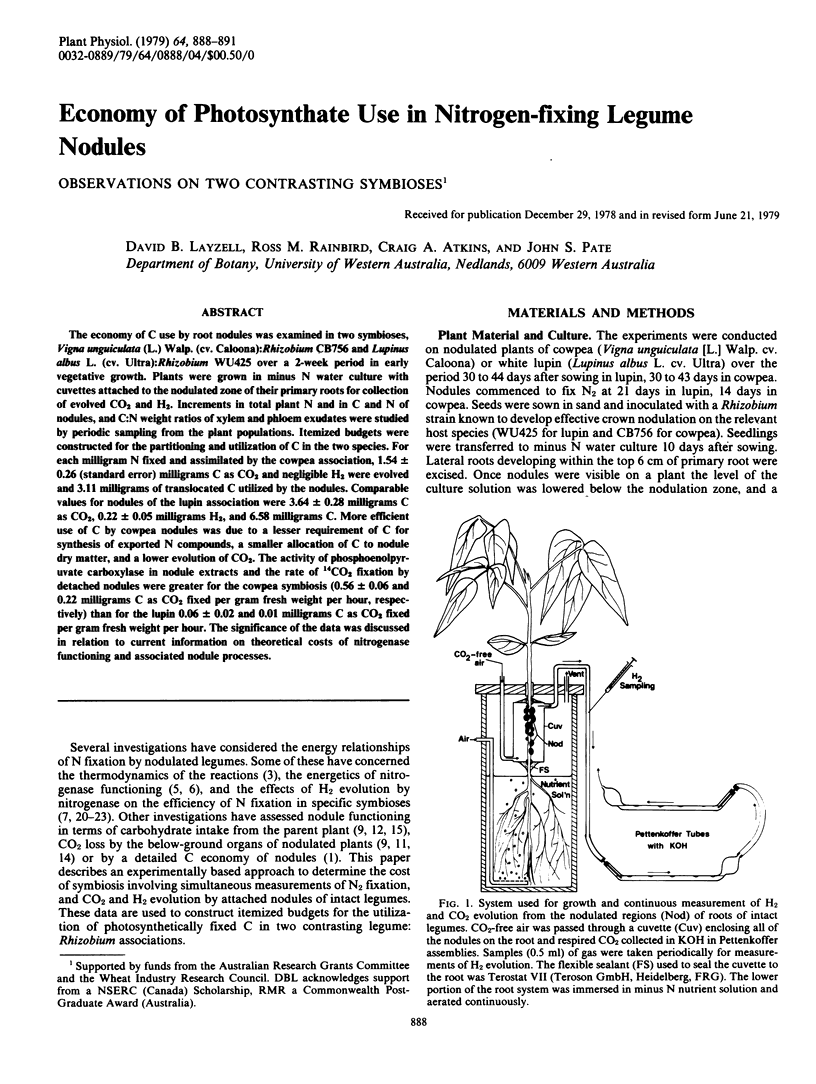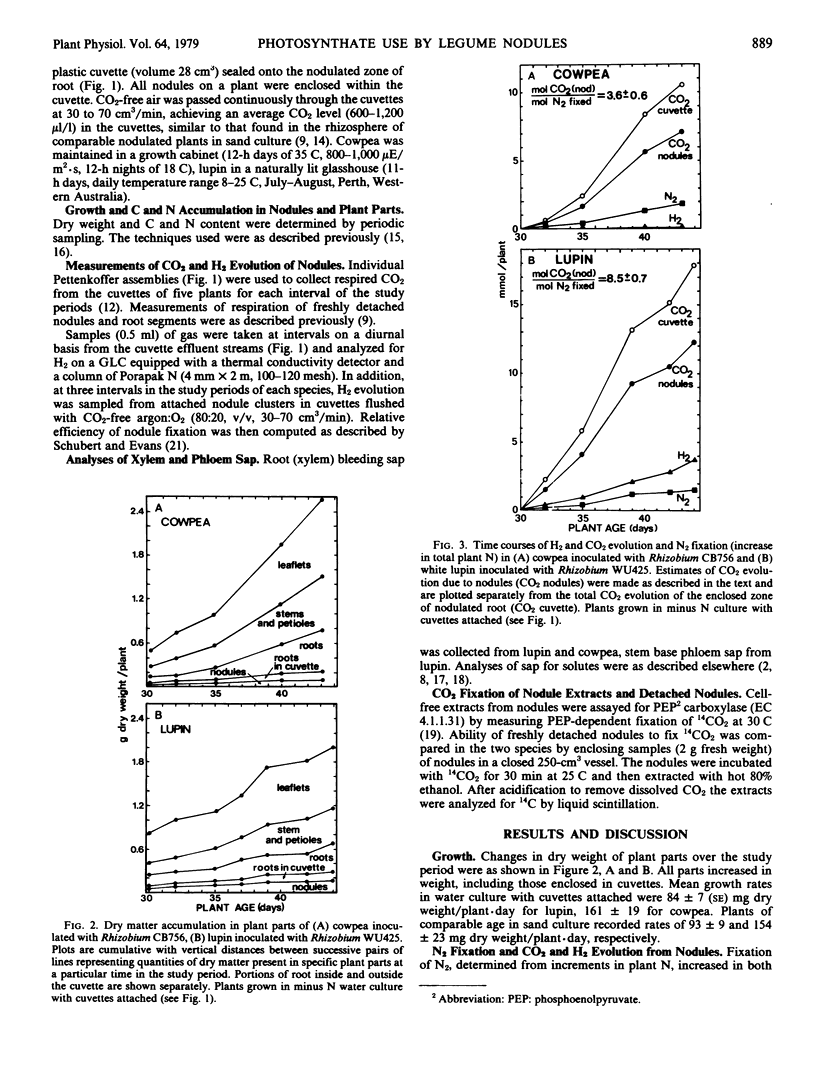Abstract
The economy of C use by root nodules was examined in two symbioses, Vigna unguiculata (L.) Walp. (cv. Caloona):Rhizobium CB756 and Lupinus albus L. (cv. Ultra):Rhizobium WU425 over a 2-week period in early vegetative growth. Plants were grown in minus N water culture with cuvettes attached to the nodulated zone of their primary roots for collection of evolved CO2 and H2. Increments in total plant N and in C and N of nodules, and C:N weight ratios of xylem and phloem exudates were studied by periodic sampling from the plant populations. Itemized budgets were constructed for the partitioning and utilization of C in the two species. For each milligram N fixed and assimilated by the cowpea association, 1.54 ± 0.26 (standard error) milligrams C as CO2 and negligible H2 were evolved and 3.11 milligrams of translocated C utilized by the nodules. Comparable values for nodules of the lupin association were 3.64 ± 0.28 milligrams C as CO2, 0.22 ± 0.05 milligrams H2, and 6.58 milligrams C. More efficient use of C by cowpea nodules was due to a lesser requirement of C for synthesis of exported N compounds, a smaller allocation of C to nodule dry matter, and a lower evolution of CO2. The activity of phosphoenolpyruvate carboxylase in nodule extracts and the rate of 14CO2 fixation by detached nodules were greater for the cowpea symbiosis (0.56 ± 0.06 and 0.22 milligrams C as CO2 fixed per gram fresh weight per hour, respectively) than for the lupin 0.06 ± 0.02 and 0.01 milligrams C as CO2 fixed per gram fresh weight per hour. The significance of the data was discussed in relation to current information on theoretical costs of nitrogenase functioning and associated nodule processes.
Full text
PDF



Selected References
These references are in PubMed. This may not be the complete list of references from this article.
- Atkins C. A., Pate J. S., Sharkey P. J. Asparagine metabolism-key to the nitrogen nutrition of developing legume seeds. Plant Physiol. 1975 Dec;56(6):807–812. doi: 10.1104/pp.56.6.807. [DOI] [PMC free article] [PubMed] [Google Scholar]
- Bethlenfalvay G. J., Abu-Shakra S. S., Phillips D. A. Interdependence of Nitrogen Nutrition and Photosynthesis in Pisum sativum L: II. Host Plant Response to Nitrogen Fixation by Rhizobium Strains. Plant Physiol. 1978 Jul;62(1):131–133. doi: 10.1104/pp.62.1.131. [DOI] [PMC free article] [PubMed] [Google Scholar]
- Dixon R. O. Nitrogenase--hydrogenase interrelationships in Rhizobia. Biochimie. 1978;60(3):233–236. doi: 10.1016/s0300-9084(78)80819-0. [DOI] [PubMed] [Google Scholar]
- Herridge D. F., Atkins C. A., Pate J. S., Rainbird R. M. Allantoin and Allantoic Acid in the Nitrogen Economy of the Cowpea (Vigna unguiculata [L.] Walp.). Plant Physiol. 1978 Oct;62(4):495–498. doi: 10.1104/pp.62.4.495. [DOI] [PMC free article] [PubMed] [Google Scholar]
- Herridge D. F., Pate J. S. Utilization of net photosynthate for nitrogen fixation and protein production in an annual legume. Plant Physiol. 1977 Nov;60(5):759–764. doi: 10.1104/pp.60.5.759. [DOI] [PMC free article] [PubMed] [Google Scholar]
- Mahon J. D. Respiration and the energy requirement for nitrogen fixation in nodulated pea roots. Plant Physiol. 1977 Dec;60(6):817–821. doi: 10.1104/pp.60.6.817. [DOI] [PMC free article] [PubMed] [Google Scholar]
- Pate J. S., Layzell D. B., McNeil D. L. Modeling the transport and utilization of carbon and nitrogen in a nodulated legume. Plant Physiol. 1979 Apr;63(4):730–737. doi: 10.1104/pp.63.4.730. [DOI] [PMC free article] [PubMed] [Google Scholar]
- Pate J. S., Sharkey P. J., Atkins C. A. Nutrition of a developing legume fruit: functional economy in terms of carbon, nitrogen, water. Plant Physiol. 1977 Mar;59(3):506–510. doi: 10.1104/pp.59.3.506. [DOI] [PMC free article] [PubMed] [Google Scholar]
- Quebedeaux B., Chollet R. Growth and Development of Soybean (Glycine max [L.] Merr.) Pods: CO(2) Exchange and Enzyme Studies. Plant Physiol. 1975 Apr;55(4):745–748. doi: 10.1104/pp.55.4.745. [DOI] [PMC free article] [PubMed] [Google Scholar]
- Schubert K. R., Engelke J. A., Russell S. A., Evans H. J. Hydrogen reactions of nodulated leguminous plants: I. Effect of rhizobial strain and plant age. Plant Physiol. 1977 Nov;60(5):651–654. doi: 10.1104/pp.60.5.651. [DOI] [PMC free article] [PubMed] [Google Scholar]
- Schubert K. R., Evans H. J. Hydrogen evolution: A major factor affecting the efficiency of nitrogen fixation in nodulated symbionts. Proc Natl Acad Sci U S A. 1976 Apr;73(4):1207–1211. doi: 10.1073/pnas.73.4.1207. [DOI] [PMC free article] [PubMed] [Google Scholar]
- Schubert K. R., Jennings N. T., Evans H. J. Hydrogen Reactions of Nodulated Leguminous Plants: II. Effects on Dry Matter Accumulation and Nitrogen Fixation. Plant Physiol. 1978 Mar;61(3):398–401. doi: 10.1104/pp.61.3.398. [DOI] [PMC free article] [PubMed] [Google Scholar]


